Climate Challenge Students Explore Hydropower at the Diablo Powerhouse
 By Elisabeth Keating, Guest Blogger
By Elisabeth Keating, Guest Blogger
On a scorching Sunday morning in August, the Climate Challenge students headed a few miles north from our riverside campground on Highway 20. Our destination: Diablo Powerhouse is a key link in the massive Skagit hydroelectricity project which provides 30-40 % of Seattle’s power supply. Our classroom for the day, the Diablo Powerhouse, has a rich and storied place in the history of Seattle. It opened in the 1930s, was built before Hoover Dam and before Grand Coulee Dam, and had the biggest hydro generators in the world when they were installed.
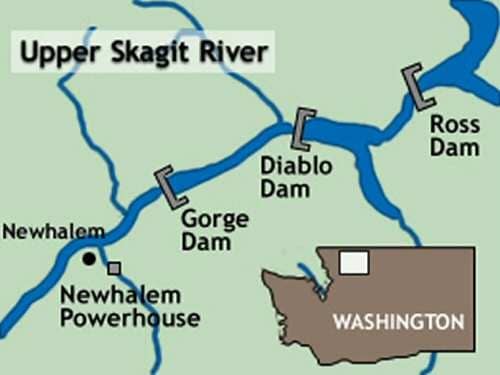 The three Seattle City Light dams on the Upper Skagit River in the Cascade Mountains today produce about 40 percent of the electrical power consumed in Seattle. The dams are located along a 7 to 8 mile section of Skagit River. Starting downriver and proceeding eastward toward Canada they are in order Gorge, Diablo, Ross.
The three Seattle City Light dams on the Upper Skagit River in the Cascade Mountains today produce about 40 percent of the electrical power consumed in Seattle. The dams are located along a 7 to 8 mile section of Skagit River. Starting downriver and proceeding eastward toward Canada they are in order Gorge, Diablo, Ross.
Today’s goal: To learn about hydro energy–a major renewable energy resource of the Pacific Northwest.
“The Cascades Climate Challenge program isn’t just about climate science and the effects of climate change on the Pacific Northwest,” lead Climate Challenge instructor Aneka explains. “It’s also about finding solutions, and alternative energy is a concept we like to explore in depth. Another primary focus of the program is leading the students to think for themselves. Through the exploration of the Diablo Powerhouse, we’re encouraging the students to think critically about the effects of climate change and solutions as they related to sustainable communities in the Pacific Northwest. Making the connection between glacial retreat and healthy salmon populations can be simple but adding the human component of energy dependence and alternatives to coal power deepen the conversation.”
Planning for hydroelectric dams began as early as 1902 and construction, but not controversy, finally concluded in 1961. The project had to overcome competition, politics, international diplomacy, the weather, and the mountains themselves. The Diablo Dam was built by Seattle City Light at a location 7-1/2 miles upstream from Newhalem and completed August 27, 1930. Due to the Great Depression, the Diablo Powerhouse was not completed until 1935, with the first power being generated in 1936.
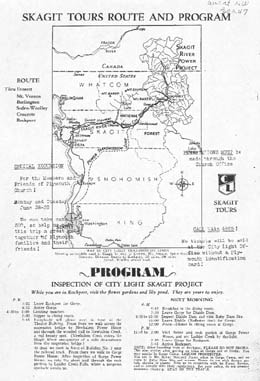 From its inception in the 1920s, the massive Skagit River power project was a tourist destination for fascinated Seattleites. This 1929 Seattle City Light flyer describes tours of the Skagit Hydro-electric project. The last 20 miles of the road to the rail head at Rockport was gravel. Courtesy Seattle Public Library.
From its inception in the 1920s, the massive Skagit River power project was a tourist destination for fascinated Seattleites. This 1929 Seattle City Light flyer describes tours of the Skagit Hydro-electric project. The last 20 miles of the road to the rail head at Rockport was gravel. Courtesy Seattle Public Library.
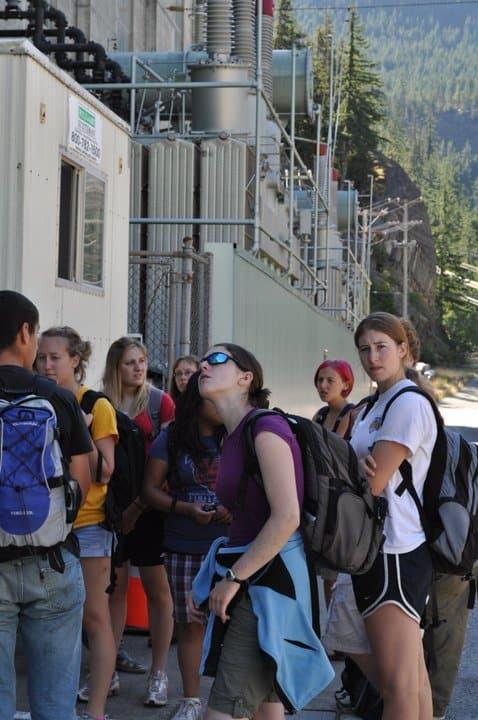 Students standing in front of the powerhouse north door (the main entrance door), with a transformer in the background.
Students standing in front of the powerhouse north door (the main entrance door), with a transformer in the background.
Our guide for the day, Seattle City Light Hydro Operator Karen Lebens, met us at the door of the Powerhouse, and welcomed us inside. The main entrance foyer is virtually unchanged in 70 years!
 The powerhouse seal in the main entrance foyer. Diablo Powerhouse was originally built with visitors in mind, thus the mosaics, seal, and a fishpond in the entrance. The generators were built up a floor higher than usual so visitors could more easily see into the turbine pits. However this design feature turned out to be one that made the powerhouse very noisy, so it wasn’t quite the visitor showplace envisioned by J D Ross.
The powerhouse seal in the main entrance foyer. Diablo Powerhouse was originally built with visitors in mind, thus the mosaics, seal, and a fishpond in the entrance. The generators were built up a floor higher than usual so visitors could more easily see into the turbine pits. However this design feature turned out to be one that made the powerhouse very noisy, so it wasn’t quite the visitor showplace envisioned by J D Ross.
It must be remembered, however, that this was very early in the development of electrical generation.
As we gathered in the control room, Karen issued earplugs and badges, and gave us a brief introduction to the complexities of hydroelectricity. The turbine of a hydropower plant uses the electricity of moving water to make electricity. The main part of a turbine is called a runner wheel with curved metal blades. Falling water hits the blades, forcing a shaft to turn. The shaft turns a magnetized wheel (rotor) inside a stationary iron ring (stator), which is embedded with coils of copper wire. Electricity is created as the magnets spin past the copper wire activating electrons. The rotor and stator are the main components of an electrical generator.
This article provides a visual diagram of how a hydroelectric dam works.
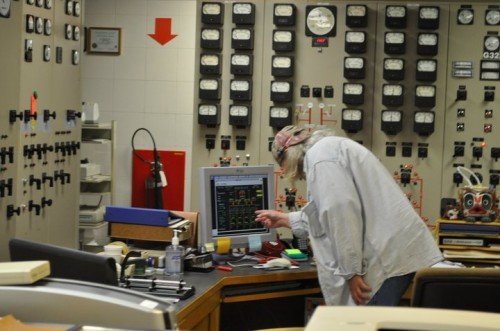 We began our tour in the control room. Here, our guide, Karen Lebens of Seattle City Light, is showing us the computer screen that gives us current information about the different plants in the Skagit River hydroelectric project, the lake levels for Ross Lake and Diablo Lake, and the weather.
We began our tour in the control room. Here, our guide, Karen Lebens of Seattle City Light, is showing us the computer screen that gives us current information about the different plants in the Skagit River hydroelectric project, the lake levels for Ross Lake and Diablo Lake, and the weather.
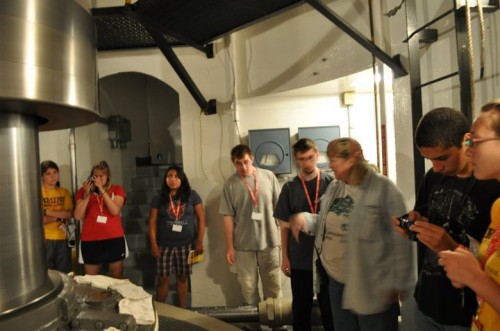 The students are inside the turbine pit of a main unit generator, looking at the turbine shaft that connects the turbine down below (being spun up by water from behind the dam) to the rotor up above (a large spinning electromagnet that is causing electricity to be generated in the stator). The water from the dam is admitted into the turbine wheel through a number of gates around its perimeter. The gates are all connected to a big shifter ring so they all open and close at the same time.
The students are inside the turbine pit of a main unit generator, looking at the turbine shaft that connects the turbine down below (being spun up by water from behind the dam) to the rotor up above (a large spinning electromagnet that is causing electricity to be generated in the stator). The water from the dam is admitted into the turbine wheel through a number of gates around its perimeter. The gates are all connected to a big shifter ring so they all open and close at the same time.
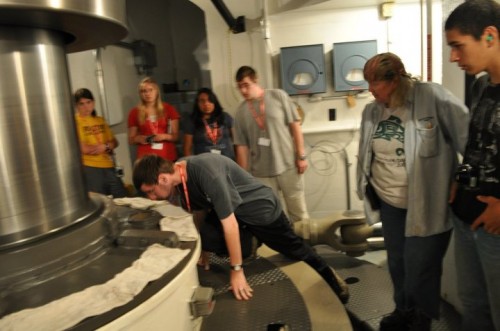 One of the students kneels on the shifter ring looking into a porthole in the bearing oil pot. There are big bearings for the turbine, the upper and lower guide bearings that keep the turbine shaft aligned, and the thrust bearing that carries the weight of the rotor as it spins. Karen explains, All of them run and oil and we can monitor oil conditions. If water got into this bearing we would see foam in the porthole and know what the problem was.
One of the students kneels on the shifter ring looking into a porthole in the bearing oil pot. There are big bearings for the turbine, the upper and lower guide bearings that keep the turbine shaft aligned, and the thrust bearing that carries the weight of the rotor as it spins. Karen explains, All of them run and oil and we can monitor oil conditions. If water got into this bearing we would see foam in the porthole and know what the problem was.
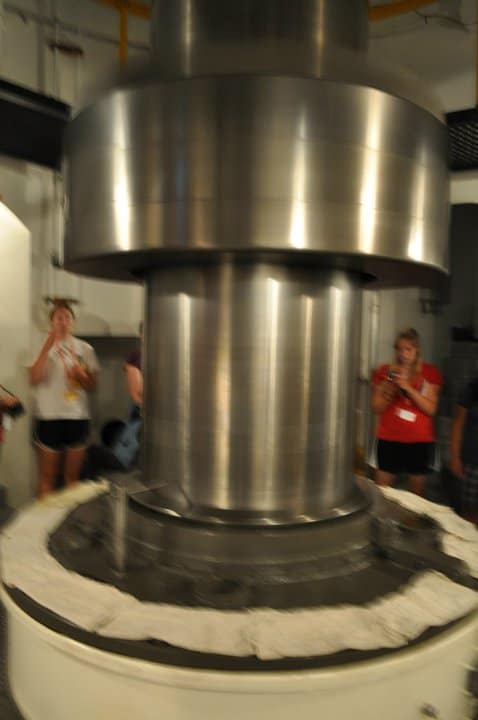 Students examine a main unit governor accumulator tank. The output of the generator is controlled by opening or closing the gates to let more or less water into the turbine. The shifter ring controls the gates by moving them using big hydraulic cylinders. The governor controls the oil to the hydraulic cylinders.
Students examine a main unit governor accumulator tank. The output of the generator is controlled by opening or closing the gates to let more or less water into the turbine. The shifter ring controls the gates by moving them using big hydraulic cylinders. The governor controls the oil to the hydraulic cylinders.
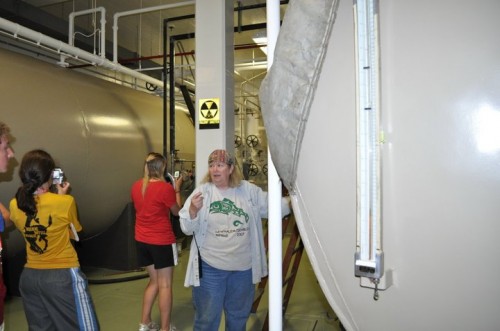 Karen shows students around the second floor relay room. Diablo is the transmission hub for the Skagit Project. Power goes onto the switchyard ring bus from all three plants and then is sent down three transmission lines all the way to Seattle. All these lines and the Diablo Powerhouse main units are protected by relays that de-energize lines or equipment if there is a fault or lightning strike or something like that.
Karen shows students around the second floor relay room. Diablo is the transmission hub for the Skagit Project. Power goes onto the switchyard ring bus from all three plants and then is sent down three transmission lines all the way to Seattle. All these lines and the Diablo Powerhouse main units are protected by relays that de-energize lines or equipment if there is a fault or lightning strike or something like that.
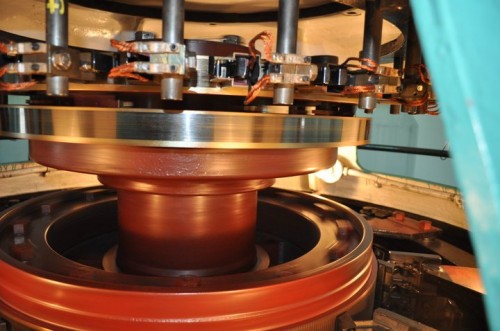 Close-up of a relay. The relaying will cause breakers to open if something happens, isolating lines or equipment. Many of the buttons and switches in the Powerhouse are the original ones installed in the 1930s. Karen says they actually are lot more durable than parts made today.
Close-up of a relay. The relaying will cause breakers to open if something happens, isolating lines or equipment. Many of the buttons and switches in the Powerhouse are the original ones installed in the 1930s. Karen says they actually are lot more durable than parts made today.
 Students prepare to climb a ladder to get a view from the on top of the stator for a main unit generator. From here, we’ll be able to get a close-up look at the huge electromagnet. The power produced by the generator is flowing on insulated copper bus bars under the floor to the right, out to the transformers that step it up to transmission voltage. Karen cautions us not to touch anything. You can look all you want, but keep your hands and fingers out of there!
Students prepare to climb a ladder to get a view from the on top of the stator for a main unit generator. From here, we’ll be able to get a close-up look at the huge electromagnet. The power produced by the generator is flowing on insulated copper bus bars under the floor to the right, out to the transformers that step it up to transmission voltage. Karen cautions us not to touch anything. You can look all you want, but keep your hands and fingers out of there!
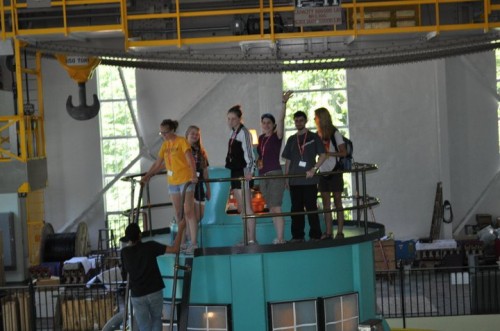 Here, students are standing the top of a main unit generator, with the powerhouse crane up above in the back. (All powerhouses need a big crane to lift the rotor into and out of the stator housing. This is the heaviest thing to lift in the powerhouse, as rotors usually run 150-300 tons, and the cranes are sized to make this lift. A powerhouse crane usually runs on rails on either side of the main generator hall walls.
Here, students are standing the top of a main unit generator, with the powerhouse crane up above in the back. (All powerhouses need a big crane to lift the rotor into and out of the stator housing. This is the heaviest thing to lift in the powerhouse, as rotors usually run 150-300 tons, and the cranes are sized to make this lift. A powerhouse crane usually runs on rails on either side of the main generator hall walls.
 The top of the main unit generator again, with crane above in background. Avery waves at the other half of the class, on top of the second generator where this picture was taken.
The top of the main unit generator again, with crane above in background. Avery waves at the other half of the class, on top of the second generator where this picture was taken.
After the tour, Karen answers questions and explains in more detail how hydropower factors into Seattle’s overall energy usage. Some interesting facts the students learned:
- Seattle and Los Angeles are the only two cities in the United States that handle both the transmission and the distribution of energy. So they are the only cities that will not go down altogether in a power outage.
- Normally, hydropower generates 30-40% of Seattle’s power. But in an emergency, the hydropower dams on the Skagit could provide up to 95% of Seattle’s power, but they could only do it for a month.
- Most hydropower dams in the U.S. are in remote locations.
- Both very high and very low levels of water kill salmon. Seattle City Light uses the controls at the Gorge Dam, the lowest dam on the river to protect salmon habitat.
- Hydro dams come in a number of different types. Two general types are run of river and reservoir. Run of river dams move water through the generators without any (or very little) stored above the generators. Reservoir dams allow for the storage of water, and therefore power to be used as it is needed most. Reservoir dams give operators more options.
After the tour I was curious to learn more about what effects the warming planet will have on the dams of the Skagit, and on energy costs for the residents of Seattle.
Seattle City Light Scott Thomsen, Sr. Strategic Advisor, Communications & Public Affairs, responded, “We consider climate change a serious threat to hydroelectric energy production. We count on snowpack to act like a battery for our dams because their reservoirs are not big enough to hold all the water needed to produce electricity throughout the year. Snowpack holds some of that water up on the mountaintops until the summer melt brings it down. If climate change causes more of our precipitation to come in the form of rain and causes the remaining snow to melt sooner, it would limit our ability to produce electricity from this clean, renewable resource. Less production from our existing dams would require us to seek other resources to meet customer needs, which would drive up costs.”
Sources of Seattle City Light’s power supply: http://www.cityofseattle.net/light/AboutUs/CustomerGuide/docs/fingertipfacts_2009.pdf
As for salmon, the Skagit is home to every type of salmon plus steelhead and bull trout. Chinook and bull trout are threatened species, which gives them special protections. City Light is committed to operating its dams in an environmentally sensitive manner. Part of that commitment is to maintain minimum river flows at critical periods of the spawning cycle to protect eggs and young fry.
Learn More about the Skagit Hydroelectric Project
These videos and articles provide more insight into the past and future of the Skagit River Hydroelectric Project.
Videos:
History in Motion: More Power To You
For a fascinating glimpse into the Diablo Powerhouse 70 years before our visit, check out this historical 24-minute video. The City of Seattle Department of Lighting made this lush color film in the late 1940s to commemorate the expansion of the Skagit River hydroelectric project. See dignitaries examining the dam, and go for a hike into the glacier-studded wilderness of the Upper Skagit River to measure the snow pack.
Essays:
History of the Upper Skagit River Hydroelectric Project
City Light’s Birth and Seattle’s Early Power Struggles, 1886-1950
Hydroelectric power from Skagit River reaches Seattle on September 14, 1924
KOL Radio broadcasts The Romance of Power live from the Skagit River on August 19, 1939
Bill Newby and Seattle City Light’s Skagit Hydroelectric Project, 1935-1996
Mementos of a Seattle City Light Skagit River tour
For more Skagit history on the web, visit the Seattle Municipal Archives site or see www.historylink.org.
University of Washington Climate Impacts Group: Climate Impacts on Washington’s Hydropower, Water Supply, Forests, Fish, and Agriculture
All photos by Elisabeth Keating (except where noted).
Special thanks to Karen Lebens and Scott Thomsen of Seattle City Light for their help with this blog post.


Fun blog post! Thanks for the informative read.